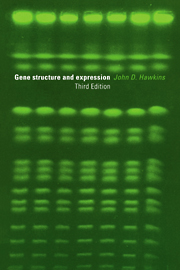Book contents
- Frontmatter
- Contents
- Introduction to the third edition
- Introduction to the second edition
- Introduction to the first edition
- List of abbreviations
- 1 Deoxyribonucleic acid (DNA)
- 2 Ribonucleic acid (RNA)
- 3 Methodology
- 4 Prokaryotic DNA replication and gene expression
- 5 The operon concept
- 6 Eukaryotic gene organisation and replication
- 7 Eukaryotic transcription
- 8 Post-transcriptional processing of RNA
- 9 Oncogenes
- 10 Haemoglobin
- 11 Proteins of the immune system
- 12 Some gene families
- 13 Mitochondrial and chloroplast genomes
- 14 Different and evolving genomes
- Glossary
- Reading lists
- Index
14 - Different and evolving genomes
Published online by Cambridge University Press: 05 June 2012
- Frontmatter
- Contents
- Introduction to the third edition
- Introduction to the second edition
- Introduction to the first edition
- List of abbreviations
- 1 Deoxyribonucleic acid (DNA)
- 2 Ribonucleic acid (RNA)
- 3 Methodology
- 4 Prokaryotic DNA replication and gene expression
- 5 The operon concept
- 6 Eukaryotic gene organisation and replication
- 7 Eukaryotic transcription
- 8 Post-transcriptional processing of RNA
- 9 Oncogenes
- 10 Haemoglobin
- 11 Proteins of the immune system
- 12 Some gene families
- 13 Mitochondrial and chloroplast genomes
- 14 Different and evolving genomes
- Glossary
- Reading lists
- Index
Summary
The structures of prokaryotic and eukaryotic genes are different
Both prokaryotic and eukaryotic genes have promoter sequences 5′- to the sites of initiation of transcription with a TATA box. This generally starts about 10 nt 5′- to this site in prokaryotes and about 30 nt from this site in eukaryotes, though in yeast it is usually further away, at 40–100 nt. It is not an invariant feature of eukaryotic promoters, but is always present in prokaryotes, where its actual sequence may influence the rate of initiation of transcription. In general, the more a TATA box deviates from the consensus sequence, the fewer mRNA transcripts will be made so that there will be very low levels of the encoded protein.
There is no sequence in eukaryotes corresponding to the prokaryotic –35 box, but eukaryotic genes typically possess a number of other upstream sequences to which trans-acting protein factors bind to regulate transcription.
The untranslated sequences 5′- to the initiation codon tend to be shorter in prokaryotes than in eukaryotes, where their length is very variable, ranging from just a few nucleotides to a thousand or more. In prokaryotes the conserved Shine–Delgarno sequence immediately 5′- to the initiation codon is used to position the mRNA on the ribosome by base-pairing. In eukaryotes, the methyl-guano sine cap at the extreme 5′-end of their mRNAs is required for binding to the ribosome. A well-conserved sequence immediately round the initiation codon presumably has a different role.
- Type
- Chapter
- Information
- Gene Structure and Expression , pp. 183 - 196Publisher: Cambridge University PressPrint publication year: 1996



